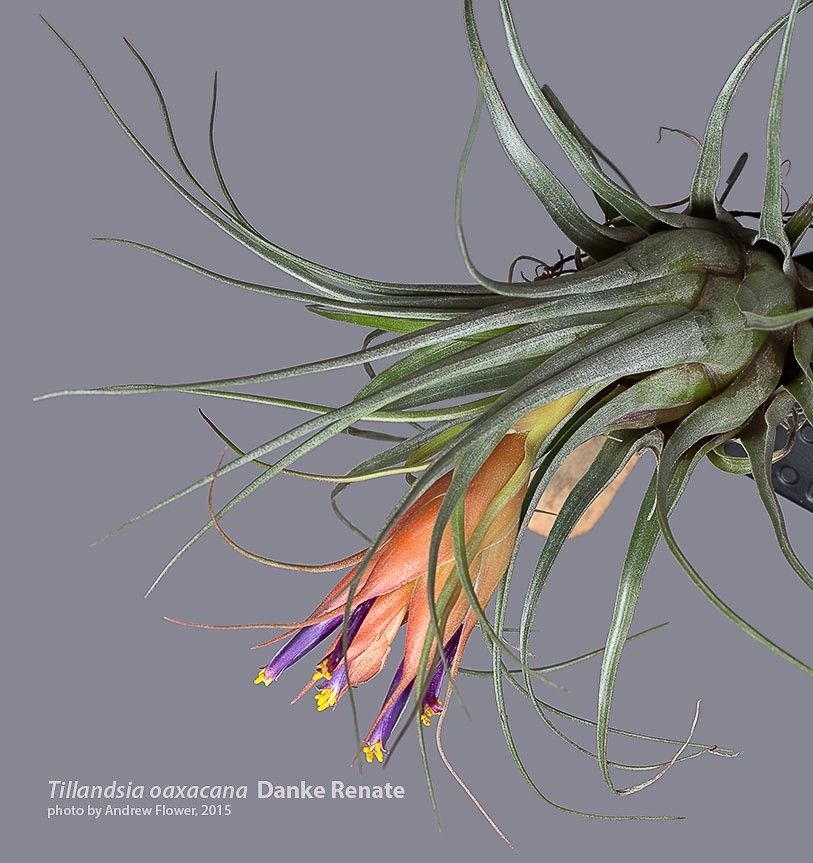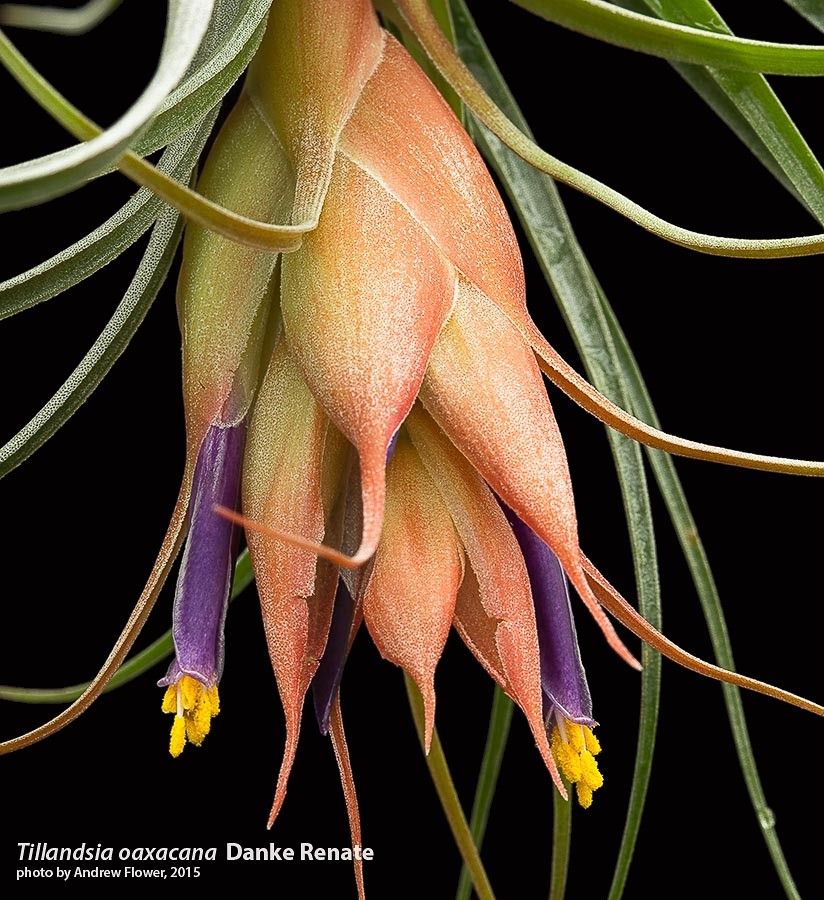

Tillandsia pseudooaxacana Ehlers spec. nov. Die Brom. 3: 92-95. 2006
A Tillandsia oaxacana L.B. Sm., cui affinis, habitu minori, foliis adpresse griseolepidotis, vaginis foliorum pallidioribus, inflorescentia breviori, floribus rhachidi attingentibus bracteis floriferis brevioribus vel aequantibus, bracteis floriferis salmoneis longioribus et filiformiter acuminates, sepalis brevioribus ecarinatis subglabris, petalis brevioribus angustioribusque, staminibus petalis subaequantibus, filamentis brevioribus, stylo breviori et stigmate luteum differt. – Typus: Mexico, Estado Oaxaca, zwischen Miahuatlan und Pochutla, 2341 m, 19.3.1993, K. & R. Ehlers EM931604 (holo MEXU, iso SEL, WU).
Paratypi: Mexico, Oaxaca, Miahuatlan - Pochutla, 2341m, 2200 m, Marz 1985, K. & R. Ehlers EM85134 (WU); 2340 m, 2300 m, 19.4.1989, K. & R. Ehlers EM891901(WU); 2350 m, 11.3.1991, K. & R. Ehlers EM912106 (MEXU, SEL, WU); 2100 m, 9.3.1998, R. Ehlers EM980601 (MEXU, WU); St. Maria Ecatepec, 28.1.2004, R. Ehlers EM040401(WU); Stary s.n. (WU).
Weitere Nachweise: Mexico, Oaxaca, zwischen Miahuatlan und San Gabriel, 2200 m. 4.12.2001, R. Ehlers EM012104; La Cinega, 2200 m, 5.2.2003, R. Ehlers EM030401.
Translated from the German by Butcher:
Plant stemless, forming an upright subbulbose rosette from many leaves, growing individually or in small groups, 15-20 cm high, 10-15 cm wide.
Leaves to 20 cm long, thin-leathery, dark-green - grey appressed scaled.
Sheaths 3–4.5 cm long, 2.5 - 4 cm wide, broad - oval, spoon-shaped curved, distinct from the sheath, abaxial black-brown appressed grey lepidote, adaxial brown with dense large brown lepidote.
Blade 1–1,5 cm wide above the sheath, to 16cm long, narrow-triangular tapering very quickly to a filiform tip, the edges bent inwards, adaxial grey-green small scaled, abaxial very densely appressed with large grey scales.
Scape short, only 2–3 cm long, bent horizontal, 5 - 8 mm in diameter, densely imbricate, (however somewhat visible) with the sheaths of the scapebracts which are similar to the inner leaves, blades to 10 cm long, the upper ones similar to the lower floral bracts.
Inflorescence 6-8cm long, 2.8-4cm wide, bent downwards, simple, egg-shaped or oval, with 9-15 polystichous flowers.
Floral bract far exceeding and covering the sepal, sheath 3–5 cm long, to 2–2.5 cm wide, oval, spoon-shape curved, very thin membranous with sub-hyaline edges, shining salmon-pink abaxial fine-pruinose lepidote, adaxial nerved and dense fine appressed lepidote, strongly enclosing the rhachis and flowers, blade narrow-triangular, becoming green, the lower floral bracts to 9 cm long, bent outwards, tapering to filiform, whereas the upper ones are gradually shorter and only caudate. The flowers at anthesis are completely masked by the sheaths of the floral bracts and are not visible, postfloral the uppermost tops of the flowers are somewhat visible.
Sepals 2.1–2.8 cm long, 7-9 mm wide, elliptical somewhat acuminate, quite thin membranous, strongly nerved, weakly minutely finely lepidote to glabrous, free, not keeled.
Petals 3.9–4.3 cm long, 5–6 mm wide narrowing to 3 -4 mm at the base, linear with rounded off tips that are a little spread, in the upper part violet, to the base and at the tip white.
Stamens enclosed, roughly as long as the flower-tube.
Filament 3.8-4 cm long, in the upper part oval 0.8 mm wide, straight, becoming ribbonlike below, white,
Anthers 1.5–2 mm long, 0.8 mm wide, elliptic, versatile joined ½ from the base, yellow, Pollen egg coloured.
Style somewhat shorter than the filament, 2.7–3.5 mm long, thin, white, Stigma small, upright, 1.5 mm long, 0.8 mm wide, yellow-white.
Ovary 7-8 mm high, at the base 2.5-3 mm wide, three-edged, conic, bright-green.
Type: Mexico, State of Oaxaca between Miahuatlan and Pochutla 2100–2300 m s. m.
EM 1978 s. n., EM 8290, Puerto Angel Oaxaca, EM 85134, EM 891901 19. 4.. 89, 2300m, EM 912106 11. 3. 1991, (2350 m), EM 931604 14. 3. 1993, leg. Klaus & Renate Ehlers, EM 980601, 9: 3. 98, (2100 m), EM 012104; 4. 12 . 01, 2350m, leg. Renate Ehlers, and between San Gabriel and Miahuatlan EM 012003, 2200 m, 5. 12. 01 leg. Renate Ehlers; Agua Blanca, 2400-2500m 21. 02. 05 EM051205
Examined material of T. oaxacana in the State of Oaxaca:
EM 821002 Tlaxiaco–Nuyoo 2 400 m, EM 821218 Tlaxiaco–San Martin 2300 m, E; 88 24 03 Tlaxiaco–Putla 2200 m, EM 921002 Tlaxiaco–Laguna, EM 980203 San Martin 2350 m, EM 012303. Tlaxiaco Nuyoo, EM051405 Pochutla – Miahuatlan 2400 m 23. 02. 05.
The plant seems to be similar to T. oaxacana L.B. Smith (syn. T. atrococcinea Matuda), but differs from this in the following characters:
Plant small,
Leaves not green but grey densely appressed lepidote,
Scape shorter,
Inflorescence oval and in the outline closed up,
Flowers not spreading but pressed to the rhachis,
Floral internodes shorter,
Petals hidden completely at anthesis under the floral bracts,
Floral bracts longer and filiform tipped.
Sepals shorter and almost glabrous not densely lepidote,
Petals much shorter and more narrow to 4.3 cm long instead of to 6 cm and only to 6 mm wide instead of to 11 mm, more brightly violet,
Stamens protruding not far from the flower but only so long as the flower tube,
Filament only to 4 cm long instead of to 6.8 cm,
Style only to 3.5 cm instead of to 6.2 cm, stigma lobes yellow instead of lilac.
Habitat and Range - State of Oaxaca. The plant grows in mixed woodland and on Pine trees at an altitude of over 2000 m in the mountains to the south and west of Miahuatlan and grows with T. carlos-hankii Matuda. In December 2001 we also discovered specimens in the main street of Miahuatlan down to the coast and also in the gigantic forest-areas between Miahuatlan and San Gabriel. In 2005 in the mountains near Nejapa near Agua Blanca.
In our trip to Mexico in 1978 we had originally found this pretty Tillandsia. At that time we thought it to be a grey form of T. atrococcinea Matuda but our friend Dr Jurg Rutschmann who had collected this plant earlier, had another opinion. On following trips, we collected this plant again and again and took photographs, as well as the green plant with the so notable black leaf sheaths that we assumed was T. atrococcinea Matuda.
Already, as reported in Die Bromelie No. 1 1990 , I had begun a particular interest in T. oaxacana, because no one seemed to really know this plant. We received even from botanical gardens many different plants under this name, that corresponded to the description but were usually forms of T. macdougallii L. B. Smith. Only our friend Dr. Jürgen Rutschmann from Basel shared our doubts.
I had determined that both T. macdougallii and T. oaxacana had been collected in December 1947 near Lachatao in the state Oaxaca by Mac Dougall. Both plants were described by L. B. Smith in 1949. A so famous and highly qualified botanist like him could never publish 2 plants that come from the same location but with so many different characteristics.
In February 1988 Klaus and I drove to Lachatao. Unfortunately, we could find only T. macdougallii L. B. Smith. However in the wide surroundings in the Sierra San Felipe below the Pass on the road to Oaxaca after Valle National we found T. macdougallii L. B. Smith and T. oaxacana together. We also found them on the route Tlaxiaco–Laguna and Tlaxiaco Nuyoo.
To solve the puzzle of T. oaxacana, I wrote to Professor L. B. Smith in Washington. In February 1988, he sent me an excellent large photo of the Holotype of T. oaxacana L. B. Smith. deposited in the Smithsonian Institute.
Now it was clear, without any doubt, that the same plant had been described by Matuda 18 years later as T. atrococcinea Matuda. In my article, I therefore put T. atrococcinea Matuda as synonym to T. oaxacana L. B. Smith. I also pointed out in 1990 on the route from Oaxaca to Puerto Angel I had found a smaller deviant form with greyer, appressed scaled leaves and a denser inflorescence.
Again and again, when I was in this area, I took advantage of the opportunity to collect plants, to photograph and to study them extensively. On later trips, I determined that this plant has a rather large range in the highlands of Oaxaca. In the same area on the route from Pochutla towards Miahutalan, where T. pseudooaxacana grows, we found T. oaxacana L. B. Smith, however 300 m higher. Both plants never mixed.
After many years of examination, I have decided that the small grey plant is an individual species, that differs in many ways from T. oaxacana, and at last, therefore now wish to publish this pretty new species.
Literature:
EHLERS R.: DIE BROMELIE; No: 2, 40, 1989
EHLERS R.: DIE BROMELIE, No., 1, 7, 1990
GARDNER, C., S.: At Systematic Study of Tillansia subgenus Tillandsia, University Microfilms Int., Ann Arbor, 1982.
MATUDA, E.,: CACTACEAS Y SUCCULENTAS MEXICANAS, Tomo 20, No., 1, 1977
Rauh, W.: Bromelien: Tillandsien u.a. kulturwürdige Bromelien, 3. Ed. Stuttgart, E., Ulmer 1990
Smith, L. B. & Downs, R., J.: Tillandsioideae (Bromeliaceae) in FLORA NEOTROPICA, Monograph 14, part 2 Hafner Press, New York, 1989.